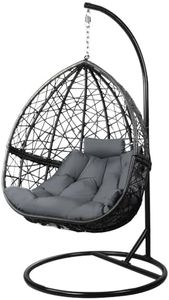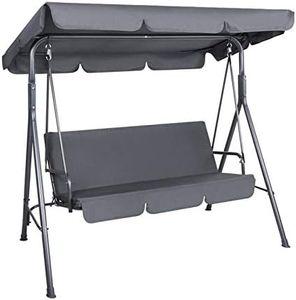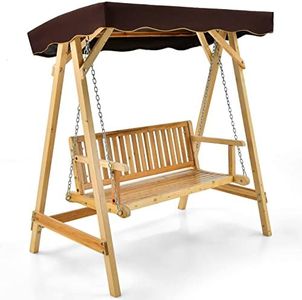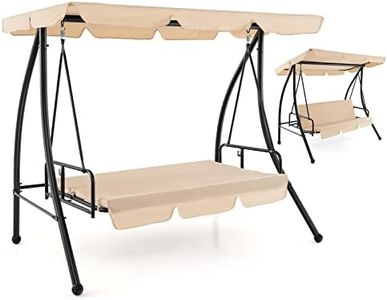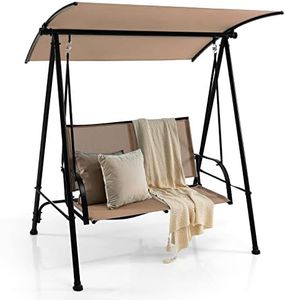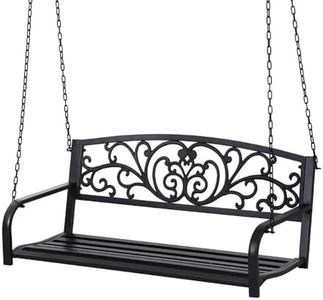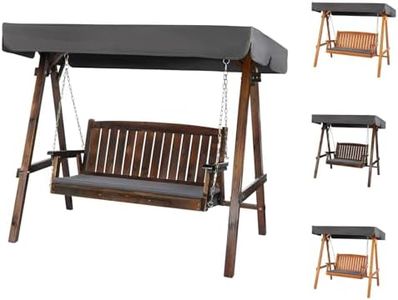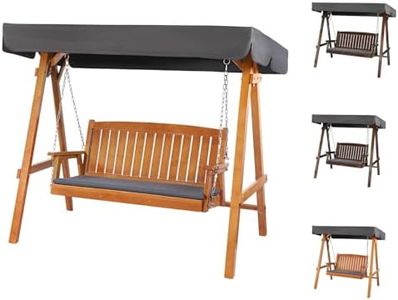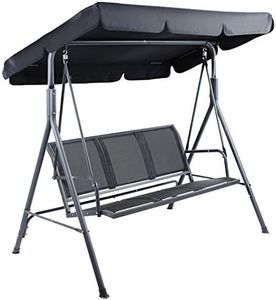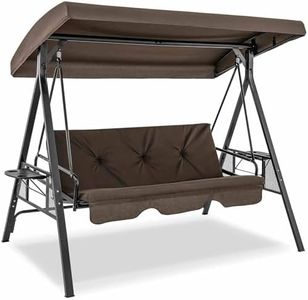We Use CookiesWe use cookies to enhance the security, performance,
functionality and for analytical and promotional activities. By continuing to browse this site you
are agreeing to our privacy policy
10 Best Patio Swings
From leading brands and best sellers available on the web.Buying Guide for the Best Patio Swings
When you’re choosing a patio swing, you’re picking a piece of outdoor furniture that should be both comfortable and durable. It’s important to consider where you’ll place it, how many people will use it, and the overall style that fits your outdoor space. Take your time to look at the materials, how easy it is to maintain, and any helpful features that will make your experience enjoyable. By understanding the key aspects, you can select a patio swing that best matches your needs and preference.Material QualityThe material of a patio swing affects its durability, comfort, and how well it handles weather. Common materials include metal, wood, and plastic, each with its pros and cons. Metal is often sturdy and can last a long time, but it might heat up in the sun or rust if not protected. Wood has a classic look and can be comfortable, but it might require regular upkeep like sealing or staining. Plastic swings are lightweight and easy to clean, but may not offer the same durability as metal or wood. To choose, think about your climate, how much effort you want to put into maintenance, and the style you want for your space.
Seating CapacitySeating capacity refers to how many people can sit on the swing at once. You’ll find single-seaters, double-seaters, and even swings that can hold three or more people. Single seats are best if you want a cozy spot just for yourself, while double or triple swings are ideal for enjoying time with family or friends. Consider who will most often use the swing and choose a size that fits your social needs as well as the space available.
Comfort and CushioningComfort depends on the swing’s design as well as the padding or cushions it includes. Some patio swings come with thick, built-in cushions, while others have basic seats that may need added cushions for more comfort. Look at the type of seating surface and the thickness of any padding. If you plan to spend long hours lounging, extra padding will help, but if the swing will only be used for short periods or by children, simpler designs might be fine.
Weather ResistanceWeather resistance means how well the swing and its components can handle outdoor conditions like rain, sun, and humidity. This often depends on the material and any finishes used, such as rust-proof coatings for metal or weatherproof fabric for cushions. If you live in an area with harsh weather, look for swings that specifically mention being weather-resistant. This will help your swing last longer and require less upkeep.
Swing MechanismThe way the swing moves—whether it’s a gentle rocking motion or a more back-and-forth glide—can make a big difference in your experience. Some patio swings use a chain mechanism, while others have a glider-style movement. Chains typically allow for more traditional swinging, while glider swings offer smoother, quieter motion. Consider which feeling you prefer and if children or elderly people will use the swing, as they might find gentler gliding swings easier and safer.
Canopy or Shade FeatureMany patio swings come with an overhead canopy or shade to protect you from sun or light rain. The size and adjustability of the canopy are important; a larger or moveable canopy offers more flexible protection. If your swing will be in a sunny spot, a canopy is almost essential for comfort and to protect your skin from UV rays. If the swing will sit in a shaded area, this feature might be less important.
Assembly and PortabilitySome patio swings come ready to use, while others require assembly. The ease with which you can put the swing together—often described in the product details—can save you time and frustration. Portability refers to how easy it is to move the swing if you want to change locations. If you think you’ll move the swing occasionally, look for models with lighter frames or wheels. For permanent placement, heavier and more anchored swings are a good choice.

